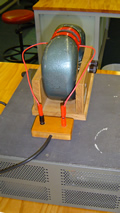Abstract
A wire carrying a DC current jumps up or down between the poles of a magnet depending on the directions of the current and magnetic field.
Portable
Yes
Principles Illustrated
Force on a DC-current carrying wire in a magnetic field.
NCEA & Science Curriculum
PHYS 2.6
Video
Above: Jumping Wire 1. Below: Jumping wire 2
Download videos (right-click and “save as”):
Jumpingwire1.m4v   (400 KB)
JumpingWire2.m4v   (800 KB)
Instructions

A long, flexible wire is best. Apply a large current briefly. Your power supply needs to tolerate short circuits, e.g. a car battery, current limited supply, or short-tolerant DC power supply such as the Unilab Electromagnetics power supply. If the DC is not smooth the wire will buzz at 50 Hz. Turn the magnet around to change the direction of the force. Change the direction of the current to change the direction of the force.
Safety
Make sure your power supply is current-limited or short-tolerant. A high voltage is not used in this demonstration but a current of several amps makes a better show.
Individual teachers are responsible for safety in their own classes. Even familiar demonstrations should be practised and safety-checked by individual teachers before they are used in a classroom.
Notes
The force on a current-carrying wire in a magnetic field is the basis of a motor.
References
PIRA 5H40.30
Teaching Resources
Would you like to contribute lesson suggestions? Contact us.
Credits
This teaching resource was developed with support from
The MacDiarmid Institute
Faculty of Science, Victoria University of Wellington
School of Chemical and Physical Sciences, Victoria University of Wellington